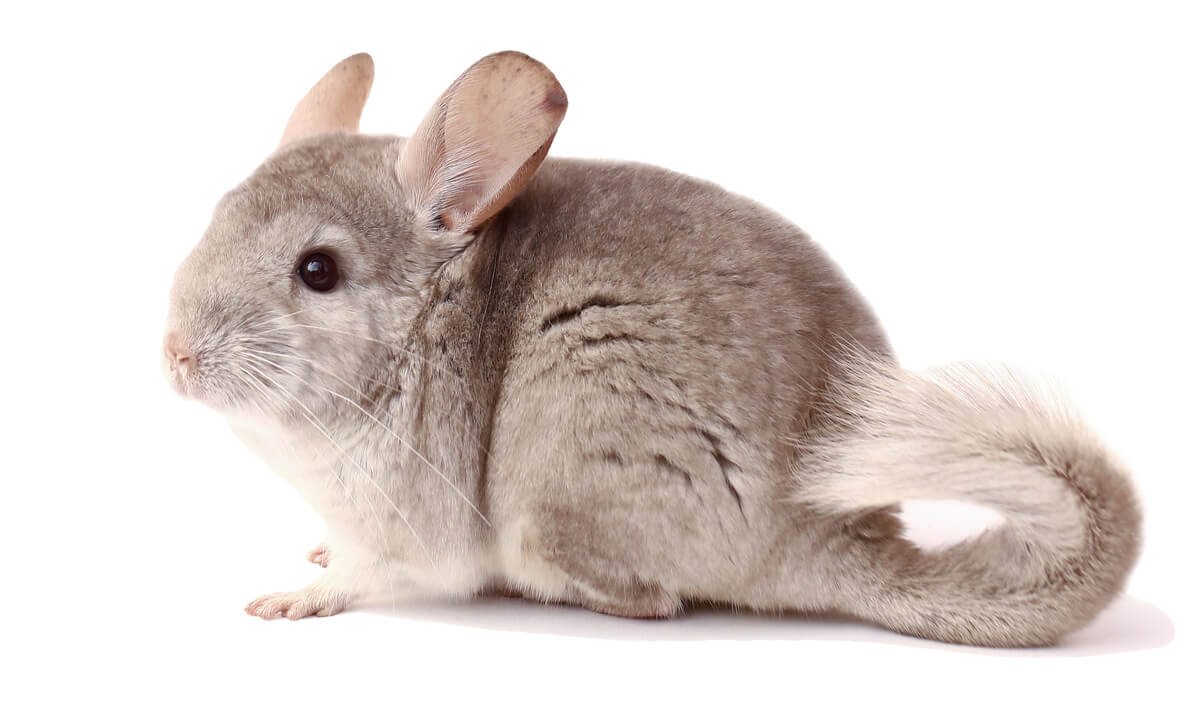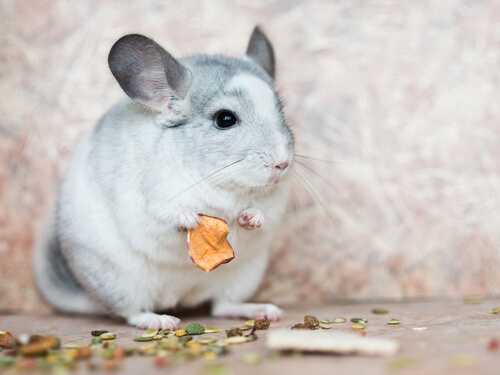Characteristics of the Chinchilla: What's It Really Like?


Written and verified by the psychologist Sara González Juárez
The chinchilla is an intelligent, sociable rodent and the best friend of many humans who have acquired them as pets. However, the variety that people keep in captivity is an artificial hybridization that was created using the two species that live in the wild, in order to help them adapt to captivity.
For this reason, in this article, you’ll find a description of the true Chinchilla genus, because we need to take a look at its natural origin in order to understand the variety that humans have created. Don’t miss this fascinating article, because these adorable rodents deserve all our attention.
Taxonomy and characteristics

When we refer to the wild chinchilla, we’re actually referring to the genus Chinchilla, to which these histrimorphic rodents of the family Chinchillidae belong. Within this genus there are 2 species:
- Chinchilla chinchilla or short-tailed chinchilla: As its name indicates, the tail is shorter than in the other species. It also has smaller and rounder ears and a more squared body, since its hair is thicker.
- Woolly or long-tailed chinchilla: This species is characterized by a more slender body, as well as a more triangular head. Its ears are large and erect and its tail is longer.
The chinchilla has a thick coat of short, but very soft fur. This, as well as their large eyes and ears and their long vibrissae, are adaptations to the cold of the arid zones they inhabit. Although many colors are found in the domestic variety due to selective breeding, chinchillas are a soft gray color, with black ear tips and white bellies.
Approximately 60 fine hairs grow in each follicle of a chinchilla’s skin.
They usually have a length of 23-38 centimeters (around 10 to 15 inches) and weigh 500-800 grams (17 to 28 oz). Females weigh more and are longer, and are considerably larger than males.
Chinchilla habitat
Both species of chinchilla inhabit the Andes Mountains. While the short-tailed chinchilla is found in southern Peru, Bolivia, northwestern Argentina and northern Chile, the woolly chinchilla can only be seen in northern Chile.
Their habitat is arid mountain areas at high elevation (3000-5000 meters). They nest in cracks and holes between rocks, where they are easily camouflaged thanks to the color of their fur. At night is when they venture out in search of food.
They are mainly herbivorous rodents, although very occasionally they may consume insects or small birds’ eggs opportunistically. They usually feed on grasses and herbs in their area. Occasionally they also consume the flesh of cacti, from which they obtain water.
When the environment is especially dry, they depend on morning dew to drink.
Chinchilla behavior
These rodents are nocturnal and gregarious. They come out at sunset and take advantage of part of the sunrise to bask in the sun. They spend the rest of the day in a rocky crevice, which they know they can fit in thanks to the vibrissae. If the vibrissae don’t bend, the chinchilla won’t get stuck.
They live in groups that can reach up to 100 individuals, but are usually not that large. They emit a large number of vocalizations to communicate, such as alarm cries (similar to a whistle), cooing to look for a mate, and warning whistles. They also often grunt and gnash their teeth.
They are thought to form matriarchal hierarchies, but research is lacking.
Reproduction
At 8 months, a chinchilla is capable of conceiving. Gestation lasts about 111-128 days and the young are born well-developed, with eyes open and weighing about 35 grams (1.2 oz). Litters aren’t very numerous, rarely reaching 3 babies.
Lactation lasts 6 to 8 weeks. From that time on, the small chinchillas begin to feed on the same food as their mother, although they may ingest some vegetable matter from birth. Females may mate within a week after giving birth, but in the wild they usually have only about two litters per year.
Chinchilla conservation status

Both the Chinchilla chinchilla and the Chinchilla lanigera are endangered (EN). They have been hunted indiscriminately for their fur, despite the fact that fur farms still exist.
To make a chinchilla fur coat you need to kill 300 of them.
The events of the El Niño phenomenon, the loss of their habitat for extensive cattle ranching, and their capture from the environment to be sold for pets have also caused their numbers to continue to decline year after year. Despite captive breeding programs and a lot of activism against fur farming, populations are still far from recovering. All that remains is to support the organizations that fight to keep these wonderful rodents where they belong, the Rocky Mountains.
The chinchilla is an intelligent, sociable rodent and the best friend of many humans who have acquired them as pets. However, the variety that people keep in captivity is an artificial hybridization that was created using the two species that live in the wild, in order to help them adapt to captivity.
For this reason, in this article, you’ll find a description of the true Chinchilla genus, because we need to take a look at its natural origin in order to understand the variety that humans have created. Don’t miss this fascinating article, because these adorable rodents deserve all our attention.
Taxonomy and characteristics

When we refer to the wild chinchilla, we’re actually referring to the genus Chinchilla, to which these histrimorphic rodents of the family Chinchillidae belong. Within this genus there are 2 species:
- Chinchilla chinchilla or short-tailed chinchilla: As its name indicates, the tail is shorter than in the other species. It also has smaller and rounder ears and a more squared body, since its hair is thicker.
- Woolly or long-tailed chinchilla: This species is characterized by a more slender body, as well as a more triangular head. Its ears are large and erect and its tail is longer.
The chinchilla has a thick coat of short, but very soft fur. This, as well as their large eyes and ears and their long vibrissae, are adaptations to the cold of the arid zones they inhabit. Although many colors are found in the domestic variety due to selective breeding, chinchillas are a soft gray color, with black ear tips and white bellies.
Approximately 60 fine hairs grow in each follicle of a chinchilla’s skin.
They usually have a length of 23-38 centimeters (around 10 to 15 inches) and weigh 500-800 grams (17 to 28 oz). Females weigh more and are longer, and are considerably larger than males.
Chinchilla habitat
Both species of chinchilla inhabit the Andes Mountains. While the short-tailed chinchilla is found in southern Peru, Bolivia, northwestern Argentina and northern Chile, the woolly chinchilla can only be seen in northern Chile.
Their habitat is arid mountain areas at high elevation (3000-5000 meters). They nest in cracks and holes between rocks, where they are easily camouflaged thanks to the color of their fur. At night is when they venture out in search of food.
They are mainly herbivorous rodents, although very occasionally they may consume insects or small birds’ eggs opportunistically. They usually feed on grasses and herbs in their area. Occasionally they also consume the flesh of cacti, from which they obtain water.
When the environment is especially dry, they depend on morning dew to drink.
Chinchilla behavior
These rodents are nocturnal and gregarious. They come out at sunset and take advantage of part of the sunrise to bask in the sun. They spend the rest of the day in a rocky crevice, which they know they can fit in thanks to the vibrissae. If the vibrissae don’t bend, the chinchilla won’t get stuck.
They live in groups that can reach up to 100 individuals, but are usually not that large. They emit a large number of vocalizations to communicate, such as alarm cries (similar to a whistle), cooing to look for a mate, and warning whistles. They also often grunt and gnash their teeth.
They are thought to form matriarchal hierarchies, but research is lacking.
Reproduction
At 8 months, a chinchilla is capable of conceiving. Gestation lasts about 111-128 days and the young are born well-developed, with eyes open and weighing about 35 grams (1.2 oz). Litters aren’t very numerous, rarely reaching 3 babies.
Lactation lasts 6 to 8 weeks. From that time on, the small chinchillas begin to feed on the same food as their mother, although they may ingest some vegetable matter from birth. Females may mate within a week after giving birth, but in the wild they usually have only about two litters per year.
Chinchilla conservation status

Both the Chinchilla chinchilla and the Chinchilla lanigera are endangered (EN). They have been hunted indiscriminately for their fur, despite the fact that fur farms still exist.
To make a chinchilla fur coat you need to kill 300 of them.
The events of the El Niño phenomenon, the loss of their habitat for extensive cattle ranching, and their capture from the environment to be sold for pets have also caused their numbers to continue to decline year after year. Despite captive breeding programs and a lot of activism against fur farming, populations are still far from recovering. All that remains is to support the organizations that fight to keep these wonderful rodents where they belong, the Rocky Mountains.
All cited sources were thoroughly reviewed by our team to ensure their quality, reliability, currency, and validity. The bibliography of this article was considered reliable and of academic or scientific accuracy.
- Roach, N. & Kennerley, R. 2016. Chinchilla chinchilla. The IUCN Red List of Threatened Species 2016: e.T4651A22191157. https://dx.doi.org/10.2305/IUCN.UK.2016-2.RLTS.T4651A22191157.en. Accessed on 24 November 2022.
- Roach, N. & Kennerley, R. 2016. Chinchilla lanigera (errata version published in 2017). The IUCN Red List of Threatened Species 2016: e.T4652A117975205. https://dx.doi.org/10.2305/IUCN.UK.2016-2.RLTS.T4652A22190974.en. Accessed on 24 November 2022.
- Chinchilla lanigera (chinchilla). (s. f.). Animal Diversity Web. https://animaldiversity.org/accounts/Chinchilla_lanigera/
- Chinchilla chinchilla (short-tailed chinchilla). (s. f.). Animal Diversity Web. https://animaldiversity.org/accounts/Chinchilla_chinchilla/
This text is provided for informational purposes only and does not replace consultation with a professional. If in doubt, consult your specialist.








